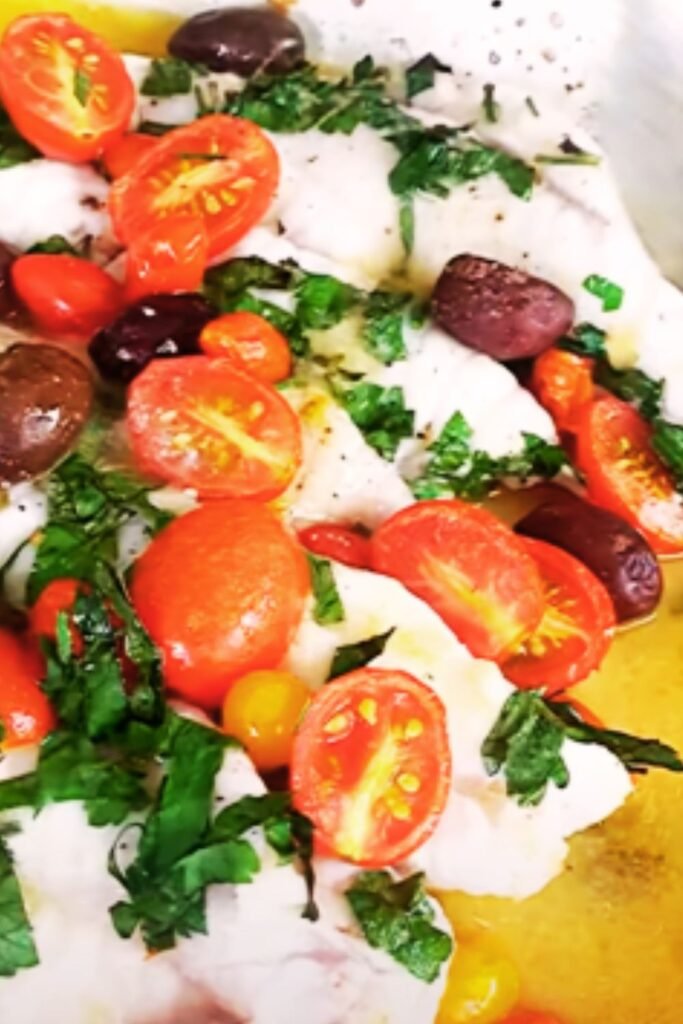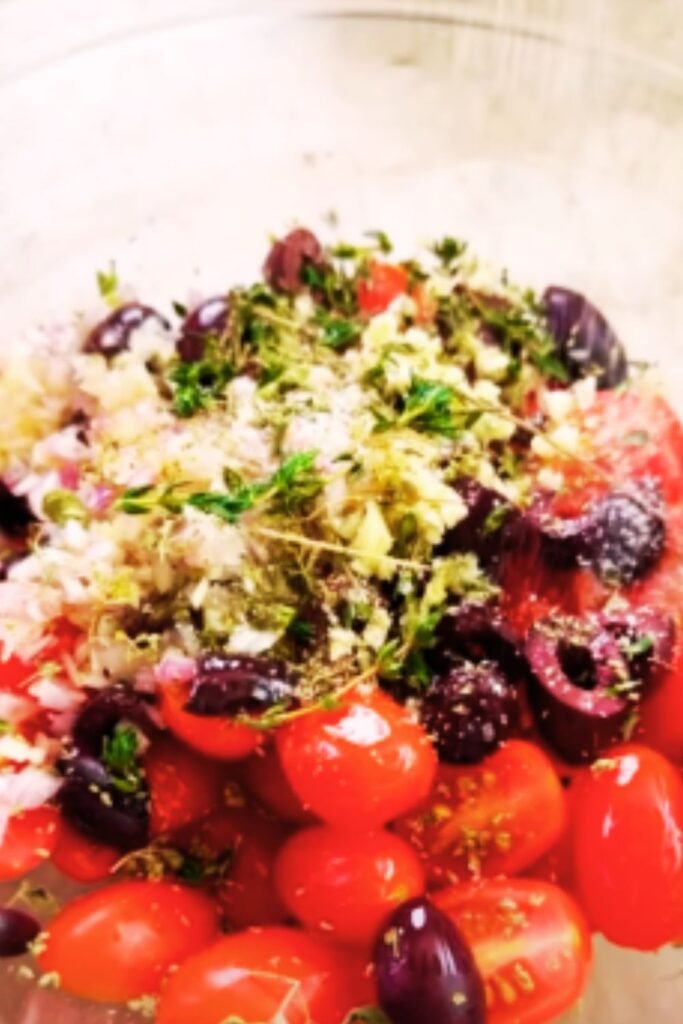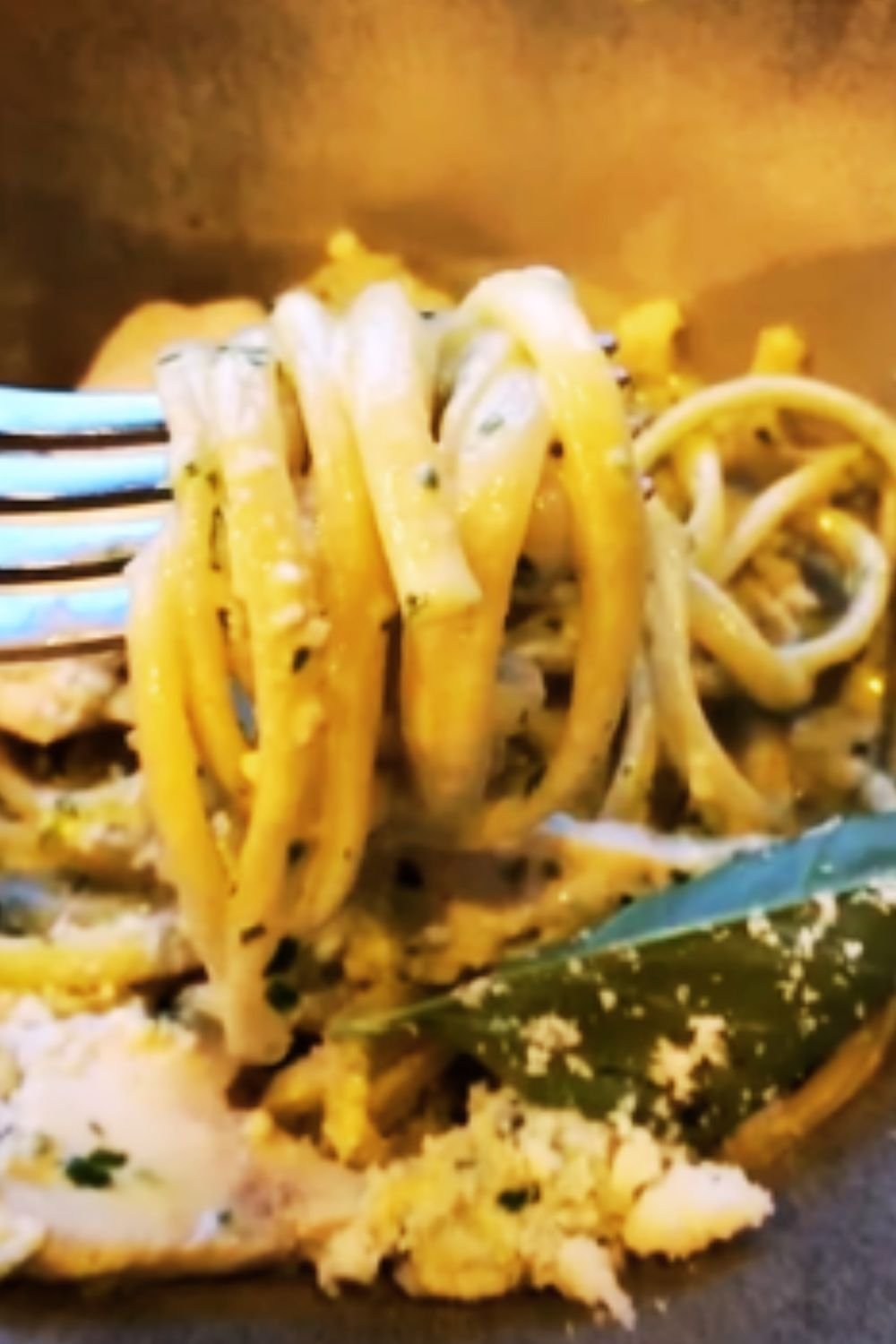There’s something magical about Mediterranean cuisine – the vibrant colors, the bold flavors, and the fresh ingredients that transport you straight to the sunny shores of Greece, Italy, or Spain. Today, I’m thrilled to share one of my absolute favorite dishes that embodies everything wonderful about Mediterranean cooking: the perfect baked fish with Mediterranean flavors.
Having spent years perfecting this recipe, I can confidently say that this dish brings together all the elements that make Mediterranean cuisine so beloved worldwide. It’s healthy, bursting with flavor, and surprisingly simple to prepare. The combination of fresh fish, aromatic herbs, and colorful vegetables creates a meal that’s not just delicious but also visually stunning.
What Makes Mediterranean Baked Fish So Special?
Mediterranean baked fish isn’t just another recipe – it’s a celebration of the region’s culinary philosophy. This approach to cooking emphasizes fresh, seasonal ingredients prepared simply to let their natural flavors shine. The Mediterranean diet has been recognized worldwide for its health benefits, and this dish is a perfect example of why.
When I first started making this dish, I was amazed at how the flavors melded together during the baking process. The fish absorbs the aromatic herbs and olive oil, while the vegetables release their juices to create a delicious sauce that requires no additional thickening agents. It’s a naturally gluten-free, protein-rich meal that’s perfect for anyone looking to eat healthier without sacrificing flavor.
The Mediterranean Diet Connection
The Mediterranean diet is consistently ranked as one of the healthiest eating patterns globally, and fish is a cornerstone of this approach to eating. Rich in omega-3 fatty acids, protein, and various micronutrients, incorporating fish like this Mediterranean baked version offers numerous health benefits:
- Heart health: The omega-3s in fish have been linked to reduced risk of heart disease
- Brain function: These same fatty acids support cognitive health
- Anti-inflammatory properties: Many of the ingredients in this dish help combat inflammation
- Balanced nutrition: The combination of lean protein, healthy fats, and vegetables creates a perfectly balanced meal
Choosing the Perfect Fish

The foundation of any great fish dish begins with selecting the right fish. For Mediterranean baked fish, you want a variety that can stand up to the bold flavors while maintaining its texture during baking. Here are my top recommendations:
| Fish Type | Flavor Profile | Texture When Baked | Best For | Sustainability Rating |
|---|---|---|---|---|
| Sea Bass | Mild, sweet | Firm, flaky | First-time fish cooks | Good – look for European farmed |
| Snapper | Mild, nutty | Moist, medium-firm | Family meals | Good – especially red snapper |
| Cod | Mild, slightly sweet | Large, tender flakes | Budget-friendly option | Varies – look for MSC certified |
| Halibut | Mild, clean | Dense, meaty | Special occasions | Fair – Pacific is better choice |
| Branzino | Delicate, mild | Tender, flaky | Whole fish presentation | Very good when farmed |
| Grouper | Sweet, mild | Firm chunks | Hearty appetite | Fair – depends on variety |
| Mahi-Mahi | Distinct, sweet | Firm, large flakes | Bold Mediterranean flavors | Very good |
When I’m shopping for fish, I always ask the fishmonger for the freshest catch available. If you’re not sure what to look for, here are my tips for selecting fresh fish:
- The eyes should be clear and bulging, not cloudy or sunken
- The fish should smell fresh and briny like the ocean, not “fishy”
- The flesh should be firm and spring back when pressed
- The gills should be bright red or pink, not brown or gray
- Whole fish should have shiny, tight scales
If you don’t have access to fresh fish, don’t worry! Good-quality frozen fish works wonderfully in this recipe. Just be sure to thaw it properly in the refrigerator overnight before cooking.
Essential Mediterranean Ingredients
What transforms a simple baked fish into a Mediterranean masterpiece? It’s all about the supporting cast of ingredients. The Mediterranean basin is home to some of the world’s most flavorful produce and pantry staples. Here’s what you’ll need to create authentic Mediterranean flavors:
The Foundation Ingredients
- Extra virgin olive oil: The lifeblood of Mediterranean cooking, providing fruity notes and healthy fats
- Fresh lemons: Both the juice and zest add brightness and acidity
- Fresh herbs: Oregano, thyme, rosemary, and parsley are classics
- Garlic: Preferably fresh cloves, sliced or minced
- Tomatoes: Cherry or Roma varieties work beautifully
- Olives: Kalamata are traditional, but any Mediterranean olive variety works well
- Capers: These little flavor bombs add a briny punch
Flavor Enhancers
- White wine: Adds acidity and depth (optional)
- Red onion or shallots: For sweet, aromatic notes
- Bell peppers: Especially red and yellow for sweetness and color
- Fennel: For a subtle anise flavor that pairs perfectly with fish
- Mediterranean spices: A pinch of smoked paprika, red pepper flakes, or sumac
My Perfect Mediterranean Baked Fish Recipe
Now that we’ve covered the foundations, let’s dive into my tried-and-true recipe that never fails to impress. This serves 4 people and takes about 45 minutes from start to finish.
Ingredients:
- 2 lbs (900g) white fish fillets (sea bass, snapper, or cod work wonderfully)
- 3 tablespoons extra virgin olive oil, plus extra for drizzling
- 4 cloves garlic, thinly sliced
- 1 large lemon (juice and zest)
- 1 pint cherry tomatoes, halved
- 1 red bell pepper, sliced
- 1 yellow bell pepper, sliced
- 1 medium red onion, thinly sliced
- 1/2 cup Kalamata olives, pitted
- 2 tablespoons capers, drained
- 1/4 cup fresh parsley, chopped
- 2 tablespoons fresh oregano leaves (or 2 teaspoons dried)
- 1 teaspoon fresh thyme leaves
- 1/4 teaspoon red pepper flakes (adjust to taste)
- 1/2 cup dry white wine (optional)
- Salt and freshly ground black pepper to taste
Equipment:
- Large baking dish (preferably ceramic or glass)
- Sharp knife and cutting board
- Measuring spoons and cups
- Microplane or zester for lemon
- Parchment paper (optional but helpful)
Instructions:
- Preheat and prepare: Set your oven to 375°F (190°C). Lightly oil your baking dish.
- Season the fish: Pat the fish fillets dry with paper towels. Season generously on both sides with salt and pepper. Place in the prepared baking dish.
- Create the Mediterranean base: In a medium bowl, combine the cherry tomatoes, sliced bell peppers, red onion, olives, capers, half the garlic, half the herbs, red pepper flakes, 2 tablespoons of olive oil, and half the lemon juice. Toss gently to combine.
- Assemble the dish: Arrange the vegetable mixture around and slightly under the fish fillets. Scatter the remaining garlic slices on top of the fish.
- Add the remaining flavors: Drizzle the fish with the remaining olive oil. Sprinkle with lemon zest. If using, pour the white wine around (not over) the fish.
- Bake to perfection: Place the baking dish in the preheated oven and bake for 18-22 minutes, depending on the thickness of your fillets. The fish is done when it flakes easily with a fork and has reached an internal temperature of 145°F (63°C).
- Finish with fresh elements: Remove from the oven and immediately drizzle with the remaining lemon juice. Scatter the remaining fresh herbs over everything.
- Rest briefly: Allow the dish to rest for 5 minutes before serving. This helps the flavors meld and ensures the fish is perfectly moist.
Chef’s Tips for Perfect Results:
When I make this dish, I pay special attention to these details that make all the difference:
- Even cooking: Try to select fish fillets of similar thickness so they cook at the same rate
- Don’t overcook: Fish continues cooking after you remove it from the oven, so take it out when it’s just barely done
- Herb timing matters: Add half your herbs before cooking and reserve the rest for fresh finishing flavor
- Parchment option: For even more moist fish, consider baking on a bed of parchment paper
- Oil quality: Use the best extra virgin olive oil you can afford – you’ll taste the difference
Variations to Try

One of the things I love most about Mediterranean cooking is its adaptability. Here are some of my favorite variations that still maintain the essence of this classic dish:
Greek-Style
Add crumbled feta cheese during the last 5 minutes of baking and include some chopped cucumber in the vegetable mixture. Finish with extra oregano and a side of tzatziki.
Spanish-Inspired
Incorporate sliced chorizo (about 2 ounces) and a pinch of saffron to the vegetable mixture. Replace the herbs with fresh parsley and a bit of smoked paprika.
Moroccan Twist
Add 1 teaspoon each of ground cumin and coriander, a cinnamon stick, and a handful of green olives instead of Kalamata. Garnish with fresh cilantro and mint instead of parsley.
Italian Riviera
Add a handful of pine nuts, substitute basil for the herbs, and include a few anchovies in the vegetable mixture. Finish with a drizzle of high-quality balsamic glaze.
Provençal Touch
Include a tablespoon of herbes de Provence in your seasoning, add some fennel bulb to your vegetables, and finish with lavender salt if available.
Serving Suggestions
The beauty of Mediterranean baked fish is that it’s nearly a complete meal on its own. The vegetables create a built-in side dish, but I like to round out the meal with these complements:
Perfect Accompaniments:
- A simple green salad dressed with lemon juice and olive oil
- Crusty whole grain bread for soaking up the delicious juices
- Steamed or roasted new potatoes with herbs
- Fluffy couscous or quinoa to absorb the savory sauce
- Greek yogurt mixed with cucumber and herbs (a simple tzatziki)
- Roasted lemon halves for squeezing over the dish
- A side of hummus and fresh vegetables
Drink Pairings:
- Sparkling water with a squeeze of lemon and sprig of mint
- Iced tea with orange slices and rosemary
- Cucumber-infused water
- Pomegranate juice spritzer
- Non-alcoholic citrus spritz
Make-Ahead and Storage Tips
I often get asked if this dish can be prepared in advance, and the answer is yes – with some caveats. Here’s how I manage it:
Prep-Ahead Options:
- Prepare the vegetable mixture up to 24 hours ahead and refrigerate in an airtight container
- Measure and mix the herbs and spices
- Clean and portion the fish, but season it just before cooking
- Slice the garnishes and store in water in the refrigerator
Storage and Leftovers:
- Store leftovers in an airtight container in the refrigerator for up to 2 days
- Reheat gently in a 300°F (150°C) oven for about 10 minutes
- The flavors often deepen overnight, making next-day leftovers extra delicious
- This dish is also delicious served cold or at room temperature the next day
Nutritional Benefits

Let’s talk about why this dish isn’t just delicious but also incredibly good for you. The Mediterranean diet has been studied extensively for its health benefits, and this dish incorporates many of its key principles.
| Nutrient | Primary Sources in This Dish | Health Benefits |
|---|---|---|
| Omega-3 Fatty Acids | Fish | Brain health, reduced inflammation, heart health |
| Monounsaturated Fats | Olive oil, olives | Cholesterol management, reduced heart disease risk |
| Lycopene | Tomatoes | Antioxidant properties, potential cancer risk reduction |
| Vitamin C | Bell peppers, tomatoes, lemon | Immune function, collagen production, iron absorption |
| Vitamin D | Fish | Bone health, immune function, mood regulation |
| Selenium | Fish | Antioxidant, thyroid function, immune support |
| Potassium | Fish, tomatoes, bell peppers | Blood pressure regulation, fluid balance, nerve function |
| Fiber | Vegetables | Digestive health, satiety, blood sugar regulation |
| Protein | Fish | Muscle maintenance, satiety, enzyme production |
| Antioxidants | Herbs, vegetables, olive oil | Cell protection, anti-aging, anti-inflammatory |
A typical serving of this Mediterranean baked fish provides approximately:
- 300-350 calories
- 30-35g protein
- 15-18g healthy fats
- 10-12g carbohydrates
- 3-4g fiber
- Rich in vitamins A, C, D, E, and B-complex
- Excellent source of minerals including selenium, potassium, and magnesium
Common Mistakes to Avoid
Through years of making this dish, I’ve learned what can go wrong and how to avoid it. Here are the most common pitfalls:
- Overcooking the fish: This is the number one mistake! Fish continues cooking after you remove it from the oven. Take it out when it just begins to flake but still looks slightly underdone in the center.
- Under-seasoning: Fish needs generous seasoning. Don’t be shy with the salt and pepper.
- Using low-quality olive oil: The olive oil is a major flavor component, not just a cooking medium. Use the best you can afford.
- Overcrowding the baking dish: Give your ingredients some space. Overcrowding leads to steaming rather than roasting.
- Not accounting for fish thickness: Adjust cooking times based on the thickness of your fillets. A good rule of thumb is 10 minutes per inch of thickness.
- Using out-of-season tomatoes: If fresh tomatoes aren’t in season, use high-quality canned cherry tomatoes instead.
- Skipping the rest period: Those 5 minutes of resting time are crucial for the juices to redistribute and flavors to settle.
Frequently Asked Questions
Q: Can I use frozen fish for this recipe? A: Absolutely! Just make sure to thaw it completely in the refrigerator overnight and pat it thoroughly dry before cooking. Frozen fish actually works very well in this recipe, as modern flash-freezing techniques preserve the fish’s quality effectively.
Q: What if I don’t have all the fresh herbs? A: While fresh herbs provide the best flavor, you can substitute dried herbs in a pinch. The conversion ratio is generally 1 tablespoon fresh herbs = 1 teaspoon dried herbs. However, always add dried herbs earlier in the cooking process and save any fresh herbs you do have for finishing the dish.
Q: Is there a good vegetarian adaptation of this recipe? A: Yes! You can replace the fish with thick slices of eggplant, portobello mushrooms, or even extra-firm tofu. Adjust the cooking time accordingly—eggplant and mushrooms typically need about 25-30 minutes, while tofu would need about 20-25 minutes.
Q: My family doesn’t like olives. Can I leave them out? A: Certainly! The beauty of Mediterranean cooking is its flexibility. You can omit the olives entirely or replace them with something your family enjoys, like artichoke hearts or sun-dried tomatoes for a similar briny punch.
Q: How do I know when the fish is perfectly cooked? A: The most reliable test is using a fork to gently flake the thickest part of the fish. When it flakes easily but is still moist and just barely translucent in the center, it’s perfect. For more precision, use an instant-read thermometer—145°F (63°C) is the target temperature.
Q: Can I make this dish spicy? A: Absolutely! The red pepper flakes already add a gentle heat, but you can increase the amount or add a finely chopped fresh chili like a Fresno or jalapeño to the vegetable mixture for more kick. You could also finish the dish with a drizzle of chili-infused olive oil.
Q: What’s the best baking dish to use? A: I prefer ceramic or glass baking dishes because they conduct heat more gently and evenly than metal. A 9×13-inch dish typically works well for the quantities in this recipe. If possible, choose a dish that’s just large enough to hold all ingredients in a single layer without overcrowding.
Q: Can I prepare this for a dinner party? A: This is actually one of my favorite dinner party dishes! You can prep all the vegetables ahead of time and even assemble everything except the fish in the baking dish a few hours in advance. Add the seasoned fish just before baking. It’s impressive yet easy enough that you won’t be stressed in the kitchen while guests are arriving.
Final Thoughts
Mediterranean baked fish embodies everything I love about cooking – it’s a harmonious blend of simple, high-quality ingredients that come together to create something truly greater than the sum of its parts. The dish is forgiving for beginners yet satisfying for experienced cooks, making it a recipe I return to again and again.
What makes this dish truly special is its ability to transport you to the sunny Mediterranean coast with just one bite. The combination of fresh fish, vibrant vegetables, aromatic herbs, and quality olive oil creates a meal that’s not just nutritious but also a genuine pleasure to eat. It’s the kind of food that nourishes both body and soul.
I encourage you to make this recipe your own. Adjust the herbs to suit your taste, experiment with different fish varieties, and incorporate seasonal vegetables. Cooking should be a joyful creative expression, and this dish gives you plenty of room to play while still delivering consistently delicious results.
Whether you’re cooking for a quiet family dinner or hosting friends for a special occasion, this Mediterranean baked fish is sure to become a favorite in your recipe collection, just as it has in mine. Enjoy the process of creating it as much as the pleasure of sharing it with those you love.


